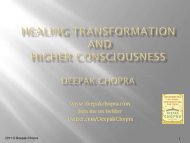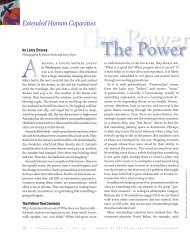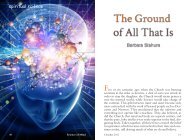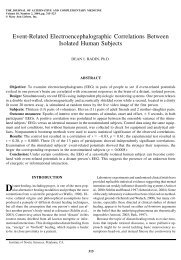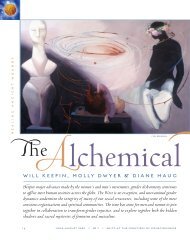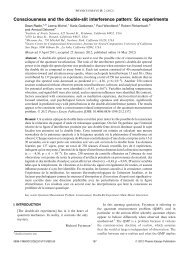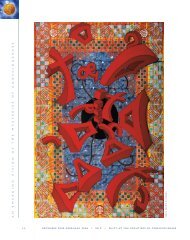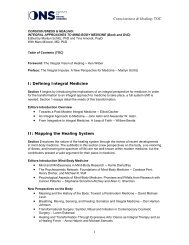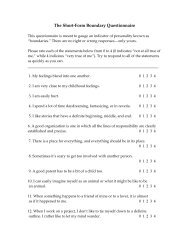Why Science Needs Art - Institute of Noetic Sciences
Why Science Needs Art - Institute of Noetic Sciences
Why Science Needs Art - Institute of Noetic Sciences
You also want an ePaper? Increase the reach of your titles
YUMPU automatically turns print PDFs into web optimized ePapers that Google loves.
In the early 1920s, Niels Bohr was struggling<br />
to reimagine the structure <strong>of</strong> matter. Previous<br />
generations <strong>of</strong> physicists had thought the inner space<br />
<strong>of</strong> an atom looked like a miniature solar system with the<br />
atomic nucleus as the sun and the whirring electrons as<br />
planets in orbit. This was the classical model.<br />
But Bohr had spent time analyzing the radiation<br />
emitted by electrons, and he realized that science needed<br />
a new metaphor. The behavior <strong>of</strong> electrons seemed to<br />
defy every conventional explanation. As Bohr said,<br />
“When it comes to atoms, language can be used only as<br />
in poetry.” Ordinary words couldn’t capture the data.<br />
Bohr had long been fascinated by cubist paintings. For<br />
him, the allure <strong>of</strong> cubism was that it shattered the certainty<br />
<strong>of</strong> the object. The art revealed the fissures in everything,<br />
turning the solidity <strong>of</strong> matter into a surreal blur.<br />
Bohr’s discerning conviction was that the invisible<br />
When we think about the scientific process, a specific<br />
vocabulary comes to mind: objectivity, experiments,<br />
facts. In the passive tense <strong>of</strong> the scientific paper, we<br />
imagine a perfect reflection <strong>of</strong> the real world. Paintings<br />
can be pr<strong>of</strong>ound, but they are always pretend.<br />
This view <strong>of</strong> science as the sole mediator <strong>of</strong> everything<br />
depends upon one unstated assumption: Scientific<br />
knowledge is a linear ascent. The history <strong>of</strong> science is<br />
supposed to obey a simple equation: Time plus data<br />
equals understanding. One day, we believe, science will<br />
solve everything.<br />
But the trajectory <strong>of</strong> science has proven to be a little more<br />
complicated. The more we know about reality—about<br />
its quantum mechanics and neural origins—the more<br />
palpable its paradoxes become. As Vladimir Nabokov, the<br />
novelist and lepidopterist, once put it, “The greater one’s<br />
science, the deeper the sense <strong>of</strong> mystery.”<br />
<strong>Why</strong> <strong>Science</strong><br />
<strong>Needs</strong> <strong>Art</strong><br />
world <strong>of</strong> the electron was essentially a cubist world. By<br />
1923, Louis de Broglie had already determined that electrons<br />
could exist as either particles or waves. What Bohr<br />
maintained was that the form they took depended on how<br />
you looked at them. Their very nature was a consequence<br />
<strong>of</strong> our observation. This meant that electrons weren’t like<br />
little planets at all. Instead, they were like one <strong>of</strong> Picasso’s<br />
deconstructed guitars, a blur <strong>of</strong> brushstrokes that only<br />
made sense once you stared at it. The art that looked so<br />
strange was actually telling the truth.<br />
A DEEPENING MYSTERY<br />
It’s hard to believe that a work <strong>of</strong> abstract art might have<br />
actually affected the history <strong>of</strong> science. Cubism seems<br />
to have nothing in common with modern physics.<br />
JONAH lEHRER<br />
Consider, for example, the history <strong>of</strong> physics. Once<br />
upon a time, and more than once, physicists thought<br />
they had the universe solved. Some obscure details<br />
remained, but the basic structure <strong>of</strong> the cosmos was<br />
understood. Out <strong>of</strong> this naïveté, relativity theory<br />
emerged, fundamentally altering classical notions<br />
about the relationship <strong>of</strong> time and space. Then came<br />
Heisenberg’s uncertainty principle and the surreal<br />
revelations <strong>of</strong> quantum physics. String theorists, in their<br />
attempts to reconcile ever widening theoretical gaps,<br />
started talking about eleven dimensions. Dark matter<br />
still makes no sense. Modern physics knows so much<br />
more about the universe, but there is still so much it<br />
doesn’t understand. For the first time, some scientists<br />
are openly wondering if we, in fact, are incapable <strong>of</strong><br />
figuring out the cosmos.<br />
SHIFT: AT THE FRONTIERS OF CONSCIOUSNESS • # 20 • SEPTEMBER–NOVEMBER 2008 9



